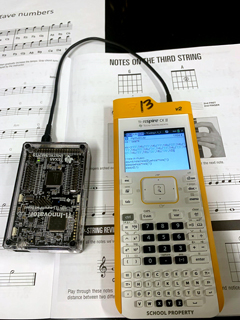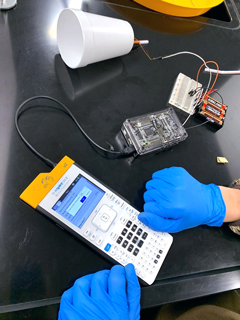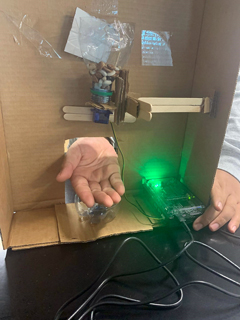To STEM and Beyond!
Posted 11/01/2021 by Stacy Thibodeaux (@stacythib)

After a crazy spring of 2020, the start of the school year in fall was definitely not back to normal. I was unsure how I was going to teach a course that was so hands-on and project-based. At that time, my district was hybrid, A/B days with alternating A/B Fridays, so I knew continuity in coding was going to be tough. I started using TI’s 10 Minutes of Code for TI-Innovator™ Technology activities in TI-Basic with my students. This allowed me to teach skills scaffolded for my beginning students as well as for me, who was still learning how to code with TI-Basic. We completed the 10 Minutes of Code activities around winter break. When we returned back after break, I started with the Path to STEM Projects. I also used some of the I/O kits to add some engineering design to the course where the students were able to get creative and design their own automatic dispenser and even a jukebox! The automatic dispenser used the built-in brightness sensor to turn a light on as well and turned a servo motor to dispense beans. The jukebox housed the TI-Innovator™ Hub, played songs and had a light show! Students used their geometry skills to code the TI-Innovator™ Rover through mazes that used the built-in RGB and range (distance) sensors. They created automated machines that used the TI-SensorLink Adapter and a Vernier sensor. Based on data input from the sensor, an action was taken. This activity was a modification from the TI STEM Project “Some Like It Tepid.” They also had an opportunity to use some of the TI STEM Projects, like the “Smart Irrigation System” and “Pet Car Alarm” projects (Figures 2, 3 and 4).



Fast forward to 2021, I still have my robotics course! School is looking more normal again, and this year we are all back full time. Last year, I started this little adventure with only one section of 23 students. Word got out on the fun we were having, and this year I have two sections with a total of 53 students! Some students have coding experiences from middle school or on their own; some have zero coding experience. All in all, they are doing a great job. With the additional capabilities of Python being available on the TI-84 Plus CE Python and the TI-Nspire™ CX II graphing calculators, we are able to use Python programming instead. I have chosen to change to Python instead of TI-Basic programming as our language for our projects because more and more industry avenues are wanting and using Python programming in their projects. This is further reason to add STEM to your classes and prepare our students for the ever-changing workforce. We have just finished the 10 Minutes of Code for Python. We are starting to use the I/O kits for a variety of projects that I have been working on with other STEM teachers who also use TI technology. After all, everything is more fun with friends. As we work our way to the end of 2021 and next spring, I plan to do some of the same projects and content that I did last year, but now in Python. I also purchased some micro:bits, and we will take on some of those projects too! If any of this interests you, please feel free to email me at svthibodeaux@gmail.com, or contact the TI STEM team or your local Educational Technology Consultant (ETC). Both can assist you with borrowing TI technology to try out STEM in your classroom, like me. You may just get hooked (and your students too! ) just like I did.
About the author: Stacy Thibodeaux is a T³™ Science National Instructor. She holds a Bachelor of Science in biology and chemistry and a master’s degree in educational leadership from the University of Louisiana at Lafayette. She is currently at Southside High School in Youngsville, Louisiana, where she teaches all levels of chemistry I and II. She uses TI technology in her Introduction to Robotics course and to assist in her teaching, data collection, and modeling of math concepts linking them to science content.
Tagcloud
Archive
- 2025
- 2024
- 2023
- 2022
-
2021
- January (2)
- February (3)
- March (5)
-
April (7)
- Top Tips for Tackling the SAT® with the TI-84 Plus CE
- Monday Night Calculus With Steve Kokoska and Tom Dick
- Which TI Calculator for the SAT® and Why?
- Top Tips From a Math Teacher for Taking the Online AP® Exam
- Celebrate National Robotics Week With Supervised Teardowns
- How To Use the TI-84 Plus Family of Graphing Calculators To Succeed on the ACT®
- AP® Statistics: 6 Math Functions You Must Know for the TI-84 Plus
- May (1)
- June (3)
- July (2)
- August (5)
- September (2)
-
October (4)
- Transformation Graphing — the Families of Functions Modular Video Series to the Rescue!
- Top 3 Halloween-Themed Classroom Activities
- In Honor of National Chemistry Week, 5 “Organic” Ways to Incorporate TI Technology Into Chemistry Class
- 5 Spook-tacular Ways to Bring the Halloween “Spirits” Into Your Classroom
- November (4)
- December (1)
-
2020
- January (2)
- February (1)
- March (3)
- April (1)
- May (2)
- July (1)
- August (2)
- September (3)
-
October (7)
- Tips for Teachers in the time of COVID-19
- Top 10 Features of TI-84 Plus for Taking the ACT®
- TI Codes Contest Winners Revealed
- Best of Chemistry Activities for the Fall Semester
- Best of Biology Activities for the Fall Semester
- Best of Physics Activities for the Fall Semester
- Best of Middle Grades Science Activities
- November (1)
- December (2)
- 2019
-
2018
- January (1)
- February (5)
- March (4)
- April (5)
- May (4)
- June (4)
- July (4)
- August (4)
- September (5)
-
October (9)
- Art in Chemistry
- Which Texas Instruments (TI) Calculator for the ACT® and Why?
- Meet TI Teacher of the Month: Jessica Kohout
- Innovation in Biology
- Learning With Your Students
- A first-of-its-kind STEM strategy charts path to help educators
- #NCTMregionals Hartford 2018 Recap
- The Math Behind “Going Viral”
- Real-World Applications of Chemistry
-
November (8)
- Testing Tips: Using Calculators on Class Assessments
- Girls in STEM: A Personal Perspective
- 5 Teachers You Should Be Following on Instagram Right Now
- Meet TI Teacher of the Month: Katie England
- End-of-Marking Period Feedback Is a Two-Way Street
- #NCTMregionals Kansas City 2018 Recap
- Slope: It Shouldn’t Just Be a Formula
- Hit a high note exploring the math behind music
- December (5)
- 2017
- 2016
- 2015
